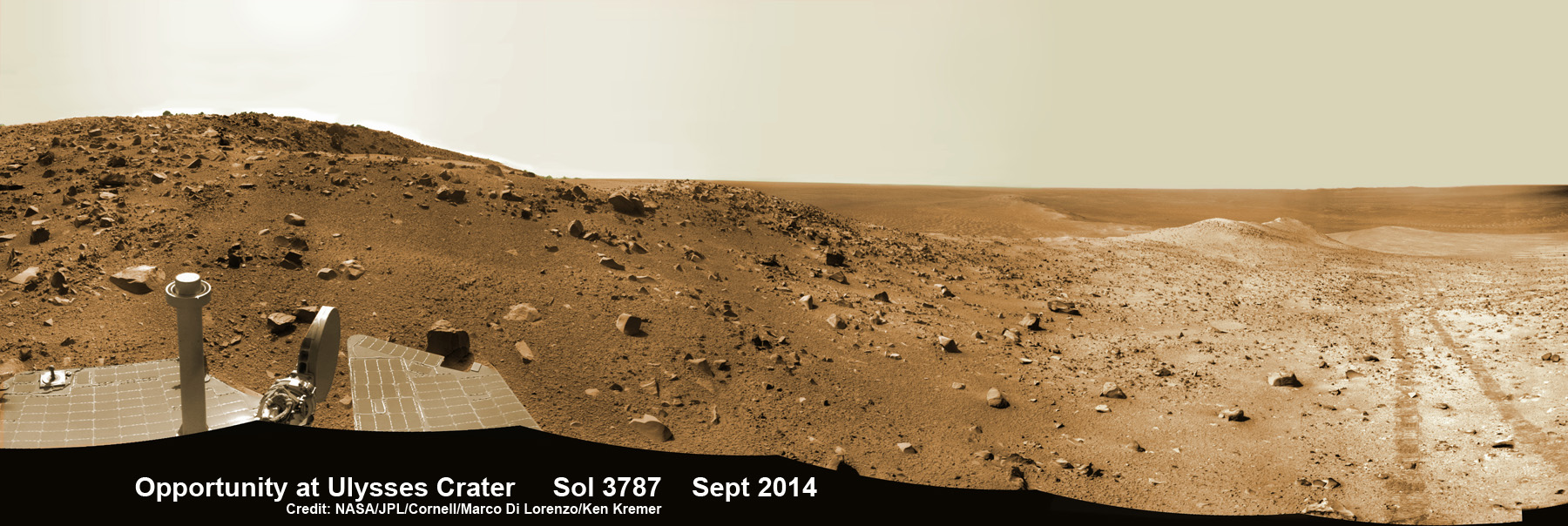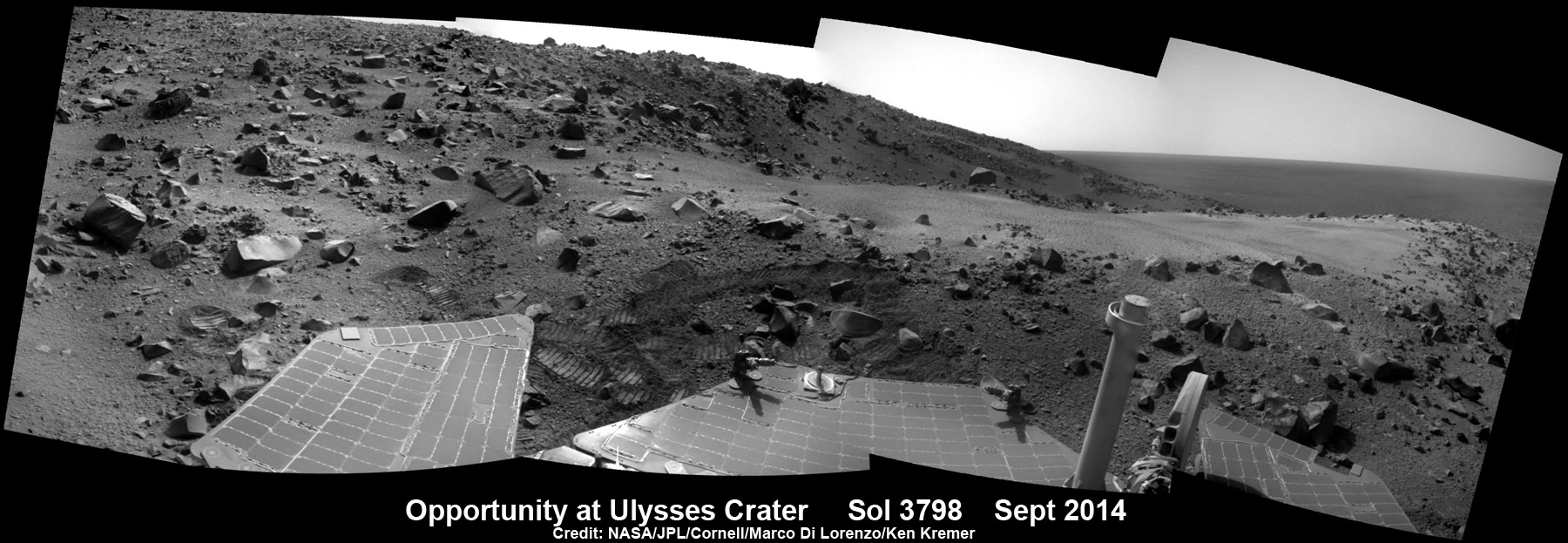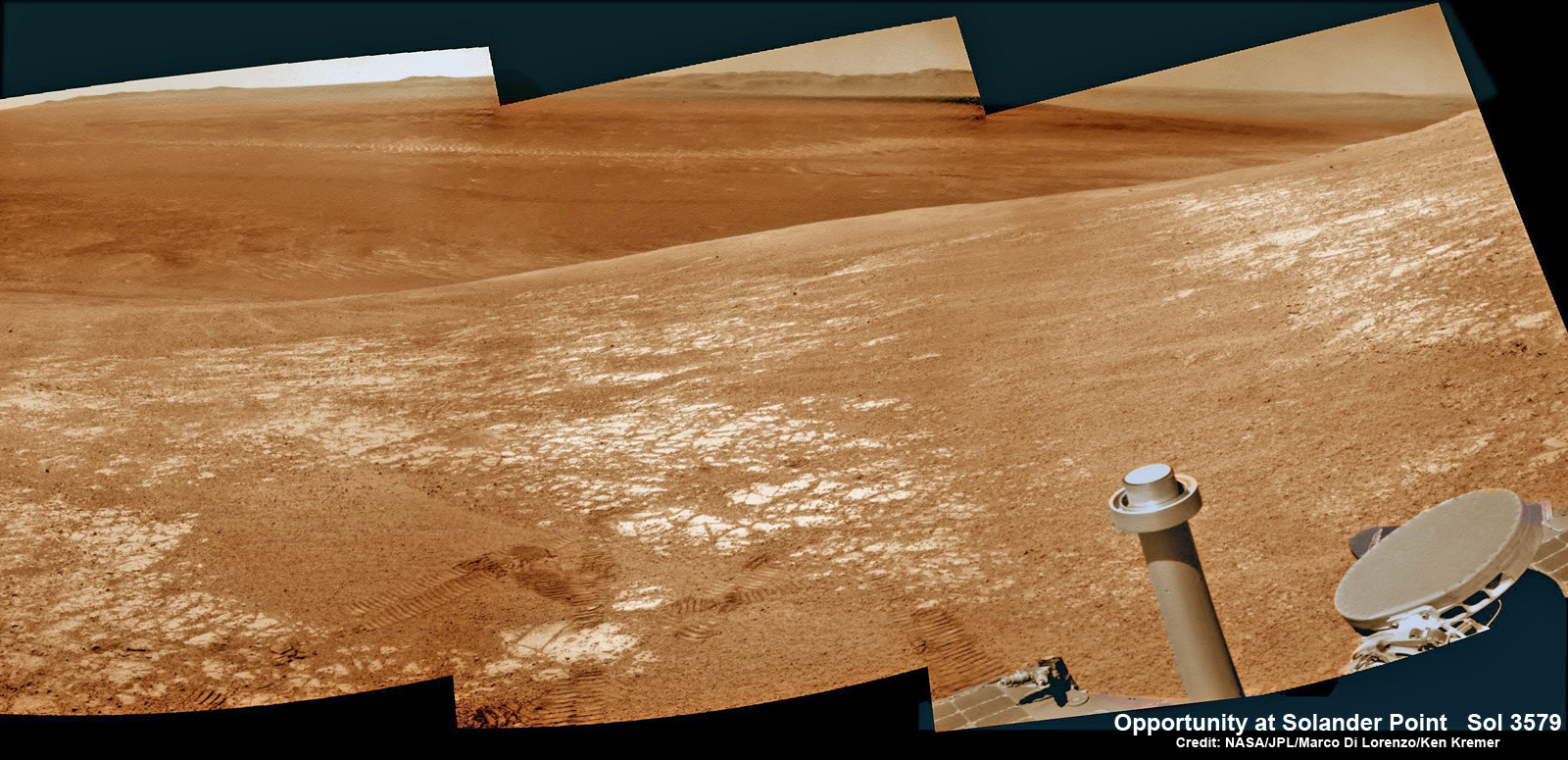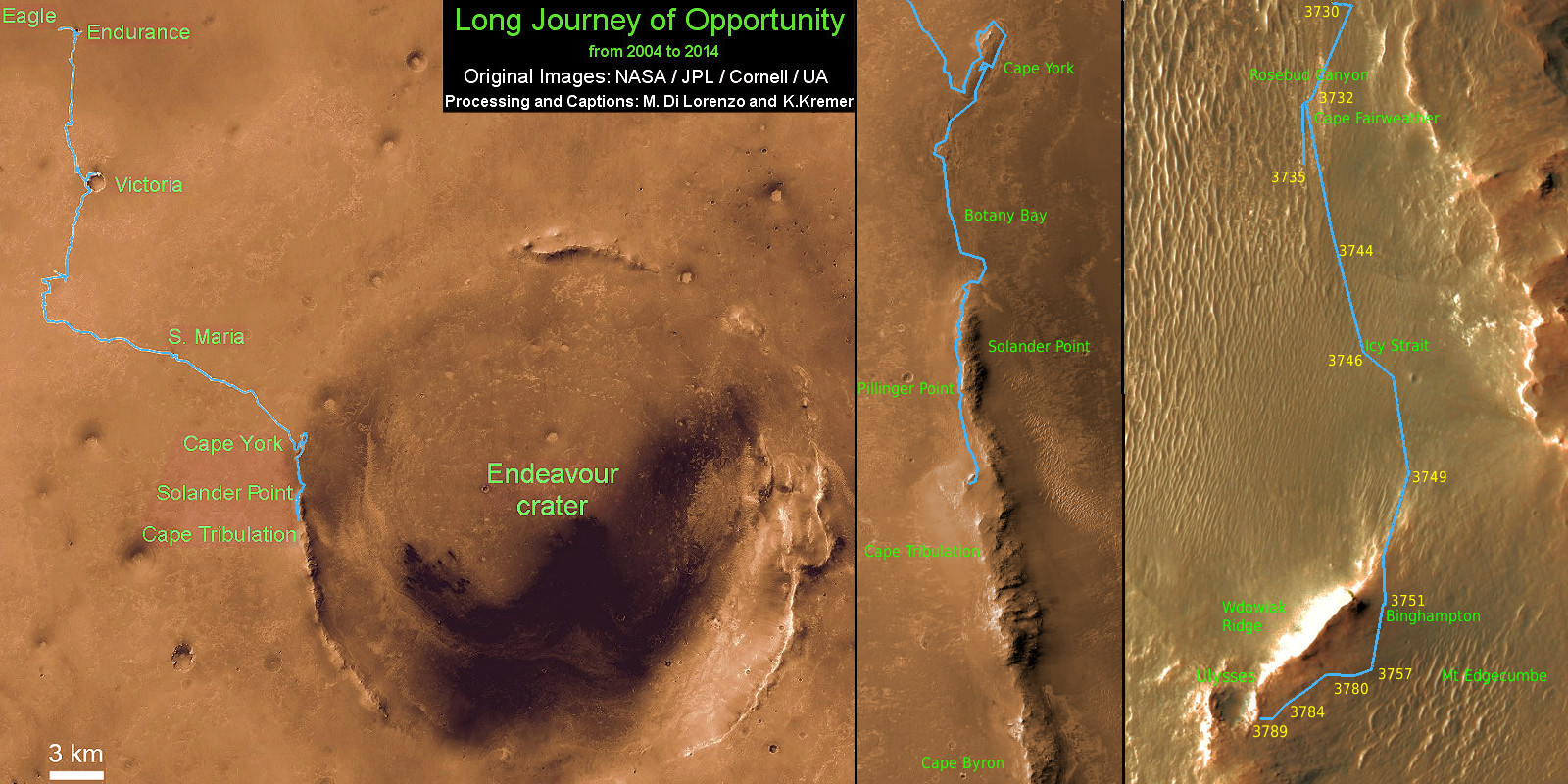
Credit: NASA/JPL/Cornell/Marco Di Lorenzo/Ken Kremer – kenkremer.com
She’s the rover that just won’t quit!
Opportunity remains hard at work today after more than 3,800 continuous Sols (days) of operation on the utterly inhospitable surface of the alien world we call Mars as an emissary from Earth.
Despite recent recurring episodes of “amnesia” ascribed to her advanced age, NASA’s long-lived Red Planet rover Opportunity is pressing on toward a scientific goldmine as she traverses southward along the ridgeline of the enormous Martian crater named Endeavour she’s been exploring for the past three years. See view from current location in our photo mosaic above showing dramatic wheel tracks as rover ascends steep crater slopes.
Endeavour crater is indeed humongous, spanning some 22 kilometers (14 miles) in diameter, and Opportunity will likely spend the remainder of her robotic life traveling around and investigating its magnificent and vast expanse.
The six-wheeled rover arrived at Endeavour’s western rim in August 2011 at a segment named “Cape York” and “began a whole new mission” as Prof. Steve Squyres, Science Principal Investigator of Cornell University, likes to say.
As Opportunity approaches her unfathomable 11th year on Mars, the resilient robot continues making excellent progress, moving to her long-term goal of “Marathon Valley,” holding rich deposits of phyllosilicates clay minerals that formed eons ago in flowing liquid, neutral water when the Red Planet was far wetter and warmer and conducive to life, compared to its cold, dry, and desiccated state today. See her entire traverse in our route map below.

Credit: NASA/JPL/Cornell/Marco Di Lorenzo/Ken Kremer – kenkremer.com
Overall, Opportunity is healthy but the team had to take corrective action in September to deal with “memory issues” and bouts of “amnesia” that happened with increasing frequency.
During August 2014 alone, Opportunity experienced a dozen computer resets that “prompted the rover team to make plans to reformat the rover’s flash memory,” because they significantly impaired the rover’s ability to carry out its planned science activities.
“Individual cells within a flash memory sector can wear out from repeated use. Reformatting clears the memory while identifying bad cells and flagging them to be avoided,” according to a NASA JPL statement.
“Worn-out cells in the flash memory are the leading suspect in causing these resets,” said John Callas of NASA’s Jet Propulsion Laboratory, Pasadena, Calif., project manager for NASA’s Mars Exploration Rover Project. “The flash reformatting is a low-risk process, as critical sequences and flight software are stored elsewhere in other non-volatile memory on the rover.”
JPL subsequently announced that Opportunity’s flash memory was successfully reformatted on Sol 3773, Sept. 9, 2014, based on an analysis of “downlinked telemetry from Mars’ most seasoned rover.”
And truly the best discoveries are yet to come, as she ascends the western rim of vast Endeavour Crater on the way to a tall rim segment named Cape Tribulation with abundant exposures of aluminum-rich clay minerals at “Marathon Valley” and located about a mile (1.6 kilometers) to the south.
The clay minerals were detected from orbit by the CRISM spectrometer aboard NASA’s powerful Martian “Spysat”—the Mars Reconnaissance Orbiter (MRO)—while gathering context data at rock outcrops along the winding way.
But that goal is still a ways off.
“The geology really gets wild at “Marathon Valley,” says rover science team member Larry Crumpler, of the New Mexico Museum of Natural History & Science (NMMNHS), in an update.
“Arrival may be March or as late as July 2015. We hope to get there way before next Mars winter so we will have plenty of time to check things out.”
Cape Tribulation holds a motherlode of the phyllosilicate clay minerals based on the extensive CRISM measurements accomplished earlier at the direction of Prof. Ray Arvidson, the rover Deputy Principal Investigator of Washington University.
“The idea is to characterize the outcrops as we go and then once we reach the valley travel quickly to Cape Tribulation and the smectite valley, which is still ~2 km to the south of the present rover location,” Arvidson told me.

In the meantime by late September, Opportunity arrived at a small impact crater named “Ulysses,” a waypoint for another science campaign. She is examining the ejecta field of scattered rocks blasted out long ago, peering inside the crater, and collecting breathtaking panoramic imagery with the navcam and pancam cameras.
The team also commanded the golf-cart-sized robot to brush a rock target named “Hoover” with the Rock Abrasion Tool (RAT), collect a Microscopic Imager (MI) mosaic of the brushed area, and then place the Alpha Particle X-ray Spectrometer (APXS) for an overnight integration, according to a JPL update.
Furthermore, Opportunity’s handlers performed test observations at twilight with the Pancam camera to prepare for upcoming unprecedented observations of Comet Siding Spring in a few weeks.
On Oct. 19, 2014, Comet Siding Spring will experience an extremely close flyby of Mars, when it passes by the planet at a distance of only 88,000 miles (139,500 kilometers). That is only about one-third the distance between the Earth and the Moon.
The rover also experienced another two bouts of amnesia and resets on Sol 3783 (Sept. 14, 2014) and Sol 3793 (Sept. 24, 2014) since the reformatting operation, but remains healthy otherwise. The team continues to investigate these anomalous flash memory events.

Opportunity has survived a decade of continuous bombardments of deadly cosmic rays and the equally endless onslaught of the sharp-edged budget axe from cold-hearted bean counters in Washington, D.C.
She is truly a miraculous lady!
Thanks to the genius of the American scientists and engineers who designed, built, launched, landed, and guided her through more than 10 years of exploration and discovery across the Martian plains, crater, and mountains of Meridiani Planum.
Today, Oct. 9, marks Opportunity’s 3807th Sol or Martian Day roving Mars. So far she has snapped over 197,200 amazing images since her air-bag assisted touchdown on Jan. 24, 2004, inside Eagle crater.
She was expected to last a mere three months, with a “warranty” of 90 Martian days (Sols). That’s an unbelievable 42 times beyond her expected warranty. It’s like we launched 42 rovers to explore the Red Planet for the price of one rover launch way back in the summer of 2003.
Opportunity also recently set the interplanetary record for distance driving on another world—more than 25.34 miles, or 40.78 kilometers.

The robot is also power-rich, following a series of fortuitous wind cleaning events that substantially cleared the dust off the power-generating solar wing arrays.
The solar array energy production currently stands at 630 watt-hours, compared to about 900 watt-hours at landing in 2004 and only about 270 watt-hours just before Christmas in December 2013.
Therefore, she has plenty of energy to continue her ground-breaking science expedition across the Red Planet’s plains and climbing up the mineral-rich mountains.
Meanwhile, younger sister Curiosity is drilling into the foothills of a truly enormous Martian mountain on the opposite side of the Red Planet.
Stay tuned here for continuing developments.
Want to keep up-to-date with all things space? Be sure to “Like” AmericaSpace on Facebook and follow us on Twitter: @AmericaSpace

This map shows the entire path the rover has driven during a decade on Mars and over 3800 Sols, or Martian days, since landing inside Eagle Crater on Jan 24, 2004 to current location at Ulysses Crater at the western rim of Endeavour Crater and heading to clay minerals at Cape Tribulation. Opportunity discovered clay minerals at Esperance on Cape York– indicative of a habitable zone. Credit: NASA/JPL/Cornell/ASU/Marco Di Lorenzo/Ken Kremer – kenkremer.com
…………….
Learn more about Commercial Space Taxis, Orion and NASA Human and Robotic Spaceflight at Ken’s upcoming presentations:
Oct 14: “What’s the Future of America’s Human Spaceflight Program with Orion and Commercial Astronaut Taxis” & “Antares/Cygnus ISS Rocket Launches from Virginia”; Princeton University, Amateur Astronomers Assoc of Princeton (AAAP), Princeton, NJ, 7:30 PM
Oct 23/24: “Antares/Cygnus ISS Rocket Launch from Virginia”; Rodeway Inn, Chincoteague, VA




I find it absolutely amazing that Opportunity has been able to continue to press forward mile after mile on an inhospitable world (dry, dusty, cosmic rays, solar wind, radiation and just the shear stress of constant day/night thermal cycling) and can still function at all. The memory chips, despite the memory errors they endure from all the cosmic particle hits and radiation, still have the capacity to be reformatted and continue to live on. Quite an accomplishment in unto itself. The mechanical structure and actuators continue to perform well under the dust contains and severe thermal cycling. This too is an extraordinary accomplishment. The solar arrays continue to produce vast amounts of energy with the help of periodic dust off events from the Martian winds…and finally the optics and aperatures for all the science cameras and instruments are holding up very well.
I hope these lessons are being learned by the engineers at NASA and all contractor companies who are designing our next generation structures for human exploration on both Earth’s moon and Mars and it’s moons.
Thanks Opportunity for your service and helping us to determine the best way to continue our exploration.
If there one day is a “Hall of Fame” for robotic explorers, Opportunity would top the list.